Deep frying
Deep frying (also referred to as deep fat frying) is a cooking method in which food is submerged in hot fat, most commonly oil, as opposed to the shallow oil used in conventional frying done in a frying pan. Normally, a deep fryer or chip pan is used for this; industrially, a pressure fryer or vacuum fryer may be used. Deep frying may also be performed using oil that is heated in a pot. Deep frying is classified as hot-fat cooking method.[1][2] Typically, deep frying foods cook quickly: all sides of a food are cooked simultaneously as oil has a high rate of heat conduction.[3]
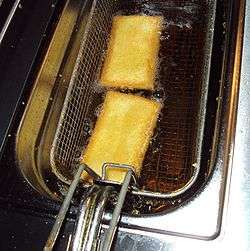
The term "deep frying" and many modern deep-fried foods were not invented until the 19th century, but the practice has been around for millennia. Early records and cookbooks suggest that the practice began in certain European countries before other countries adopted the practice.
Deep frying is popular worldwide, with deep-fried foods accounting for a large portion of global caloric consumption. Many foods are deep-fried and cultures surrounding deep frying have developed, most notably in the Southern United States and the United Kingdom, where many events and records are held relating to deep frying food and non-edible items.
History
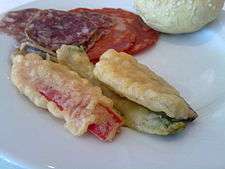
The English expression deep-fried is attested from the early 20th century.[4]
Frying food in olive oil is attested in Classical Greece from about the 5th century BCE.[5] The practice of deep frying spread to other parts of Europe and Arabia in the following centuries. Deep-fried foods such as funnel cakes arrived in northern Europe by the 13th century,[6] and deep-fried fish recipes have been found in cookbooks in Spain and Portugal at around the same time.[7] Falafel arrived in the Middle East from population migrations from Egypt as soon as the 14th century.[8][9][10]
Evidence of potato frying can be found as early as the late 17th century in Europe.[7] French fries, invented in the late 18th century, became popular in the early 19th century western Europe.[11] In 1860 Joseph Malin combined deep fried fish with chips (french fries) to open the first fish and chip shop in London.[12]
Modern deep frying in the United States began in the 19th century with the growing popularity of cast iron, particularly around the American South which led to the development of many modern deep-fried dishes.[12] Doughnuts were invented in the mid-19th century,[13] with foods such as onion rings,[14] deep-fried turkey,[15] and corn dogs[16] all being invented in the early 20th century. In recent years, the growth of fast food has expanded the reach of deep-fried foods,[17] especially French fries.
Technique
Deep frying food is defined as a process where food is completely submerged in hot oil at temperatures typically between 350 °F (177 °C) and 375 °F (191 °C). One common method for preparing food for deep frying involves adding multiple layers of batter around the food, such as cornmeal, flour, or tempura; breadcrumbs may also be used.[18] After the food is submerged in oil, the surface of it begins to dehydrate and it undergoes Maillard reactions which break down sugars and proteins, creating the golden brown exterior of the food. Once the surface is dehydrated, it forms a crust which prevents further oil absorption. The heat conducts throughout the food causing proteins to denature, starches to undergo starch gelatinization, and dietary fiber to soften.[19]
While most foods need batter coatings for protection, it is not as necessary for cooked noodles and potatoes because their high starch content enables them to hold more moisture and resist shrinking. Meats may be cooked before deep frying to ensure that they are done inside while keeping juiciness.[20]
When performed properly, deep frying does not make food excessively greasy, because the moisture in the food repels the oil. The hot oil heats the water within the food, steaming it; oil cannot go against the direction of this powerful flow because (due to its high temperature) the water vapor pushes the bubbles toward the surface.[3][21] As long as the oil is hot enough and the food is not immersed in the oil for too long, oil penetration will be confined to the outer surface. Foods deep-fried at proper temperatures typically absorb "no more than a couple of tablespoons per 2 1⁄2 cups of oil" used.[22] This oil absorption rate is around the same as occurs with shallow frying,[22] such as in a pan.

However, if the food is cooked in the oil for too long, much of the water will be lost and the oil will begin to penetrate the food. The correct frying temperature depends on the thickness and type of food, but in most cases it lies between 350–375 °F (177–191 °C).[18][23] An informal test for a temperature close to this range involves adding a tiny amount of flour into the oil and watching to see if it sizzles without immediately burning. A second test involves adding one piece of food to deep fry and watching it sink somewhat and rise back up. Sinking without resurfacing indicates that the oil is too cold; not sinking at all indicates that the oil is too hot.[18]
It is recommended that deep fryers be cleaned often to prevent contamination.[24] The process of cooking with oil can also contaminate nearby surfaces as oil may splatter on adjacent areas. Oil vapors can also condense on more distant surfaces such as walls and ceilings. Supplies such as dish detergent and baking soda can effectively clean affected surfaces.[24]
Tools
Deep frying is done with a deep fryer, a pan such as a wok or chip pan, a Dutch oven, or a cast-iron pot. Additional tools include fry baskets, which are used to contain foods in a deep fryer and to strain foods when removed from the oil, and cooking thermometers, used to gauge oil temperature. Tongs, slotted spoons, wooden spoons, and sieves may be used to remove or separate foods from the hot oil.[25][26]
Japanese deep frying tools include long metal chopsticks; the agemono-nabe deep frying pot, which is heavy for retaining heat and deep for holding oil; the ami-shakushi net ladle used for scooping out batter debris; and the abura-kiri oil drying rack pan.[27]
- Deep frying tools
- A deep fryer with slotted spoon, for removing foods from the hot oil
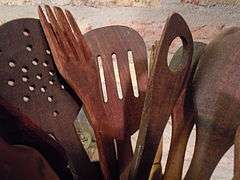 Slotted and perforated wooden spoons
Slotted and perforated wooden spoons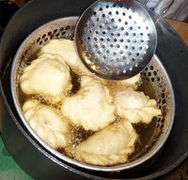 A strainer used in the preparation of empanadas
A strainer used in the preparation of empanadas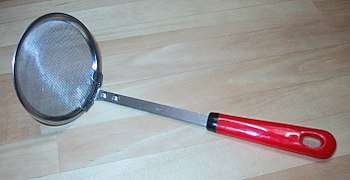 An ami shakushi is a Japanese ladle or scoop that may be used to remove small drops of batter during the frying of tempura.
An ami shakushi is a Japanese ladle or scoop that may be used to remove small drops of batter during the frying of tempura.
Dishes, foods, and culture
Deep-fried foods are common in many countries, and have also been described as "a staple of almost all street cuisines on all continents".[28] There are hundreds of dishes that are associated with deep frying as most foods can be deep-fried. Examples of food that can be deep-fried include meat, poultry, fish and vegetables.[29] Fish and chips, for instance, combines deep-fried fish and deep-fried potatoes. French fries, doughnuts, onion rings, and hushpuppies are common deep-fried foods.[30] Other common deep-fried foods include Chinese You Bing deep-fried pancakes,[31] Southeast Asian Jin deui, and Japanese tempura. Less common deep-fried foods include maple leaves,[32] peanut butter and jelly sandwiches,[33] pizza,[34] and Snickers bars.[35]
In the United States, the Chicago Tribune notes that "you can deep fry almost anything".[36] The American South has been noted as a modern center of innovation in the area of deep-fried food. According to the owner of a deep frying restaurant in the South, "If something is edible, you can bet that someone south of the Mason-Dixon line has tried to cook it in oil".[37]
 French fries being cooked in a row of deep fryers
French fries being cooked in a row of deep fryers- Deep-frying chicken in a pan
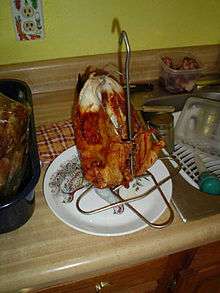
 Deep-fried Swordfish collar
Deep-fried Swordfish collar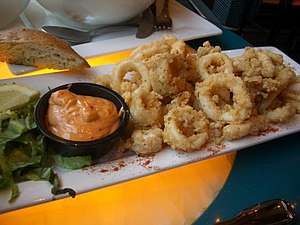 Breaded, deep-fried calamari
Breaded, deep-fried calamari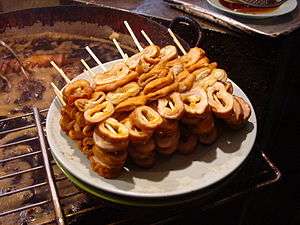 Deep fried pork intestines
Deep fried pork intestines
Africa
In Northern Africa, deep-fried dishes are a part of the cuisine.[38] A common food in this region is the deep-fried fritter, also referred to as "sponges".[38] In East Africa deep fried food is common, cooked in cast iron or earthenware pots. Frying in batter is common. A Ugandan speciality is a kind of doughnut called Mandazi. In areas of Southern Africa, street foods include deep-fried potato and cassava chips.[39] Deep-fried foods in the country of South Africa include fish and chips, vetkoek and koeksisters,[40] among others.
Asia
Japanese tempura is a popular deep-fried food[41] that generally consists of battered and fried seafood and vegetables. Japanese deep-fried dishes, or Agemono, include other styles besides tempura, such as Karaage, Korokke, Kushikatsu, and Tonkatsu.
In areas of Southeast Asia such as Thailand, insects are commonly deep-fried for human consumption.[42] Western-style fast food items such as donuts, deep-fried chicken, and deep-fried potatoes are also becoming popular in Asia.[43]
Deep-fried fish, tofu, and chả giò are commonly eaten in Vietnamese cuisine.[44][45] Deep frying is also used to make several kinds of bánh, including bánh rán (fried rice ball), bánh cam (sesame ball), bánh tiêu (hollow doughnut), bánh rế (sweet potato pancake), bánh chuối chiên (banana fritter), Hồ Tây–style bánh tôm (shrimp fritter), and bánh gối (pillow cake).
Deep-fried sticks of dough, known as youtiao in Chinese, are eaten in many East and Southeast Asian cuisines.
In Hong Kong, deep-fried intestine of pigs is a popular food.
In South Asia, popular deep fried snacks are samosa, jalebi, and pakora.
Europe
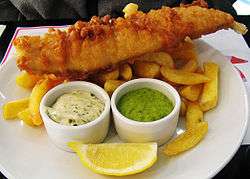
Many countries in Europe use pure or hydrogenated rapeseed oil for deep-frying.[46] The deep-fried Mars bar originated in Scotland,[47] with The Carron Fish Bar in Stonehaven claiming to have invented it in the early 1990s.[48] Fish and chips is a very popular deep-fried dish in England since it originated in London in the 19th century and became popular among the working class. Its popularity continues with 229 million portions of fish and chips being sold annually in England.[49]
There is an annual trade fair devoted to deep-fried foods called the International Symposium on Deep-Fat Frying which features discussions on deep fat frying as well as exhibitions by companies involved with the process.[50]
Belgian tradition requires French fries to be deep-fried in filtered fat of cattle, locally called blanc de boeuf or ossewit.
North America
In the United States, soybean oil is often used for deep-frying.[46] Beignets, originally a French dish, are a popular deep-fried pastry in the U.S. city of New Orleans. Deep-fried food has been a core part of the culture of the American South with many restaurants solely serving deep-fried foods. The owner of one such restaurant has said that the deep-fried food, "in the South it's a way of life".[37] Fast food is one of the most common ways to consume deep-fried food in North America.
Novelty deep-fried foods are popular today in American fairs, especially those in the American South.[37] Hundreds of items are served at these fairs. Some of them include deep-fried beer, butter, and bubblegum.[7] Additionally, deep frying can be used as a form of artwork by frying non-edible objects, such as electronics.[51] Artists such as Henry Hargreaves have deep-fried replicas of electronic items such as iPads, Game Boys, and laptops.[52]
Deep-fried food contests are frequently held at fairs such as the Texas State Fair, where they hold an annual contest for the most creative deep-fried food.[53] Notable past winners have included fried Coke and deep-fried butter, both invented by Abel Gonzales.[54] Since 2013, an American reality competition show called deep-fried Masters, produced by Discovery Networks, holds deep frying competitions at several state fairs across the country.[55]
Oceania
Milk bars in Australia may purvey several types of deep-fried foods, along with other food types.[56]
South America
The buñuelo, a fried dough ball popular in Central America and Greece, is a popular deep-fried snack and street food in South America.[28] Picarone, a Peruvian dessert originated in the colonial period, are deep-fried cakes made with pumpkin and sweet potatoes, popular in Peru and Chile, especially during harvest festivals.[57]
Oil deterioration and chemical changes
Deep fat frying involves heating oil to temperatures in excess of 180 °C in the presence of moisture and air. These conditions can induce a series of complex chemical reactions which may impact the quality of both the food and the oil it is cooked in. Examples of different chemical reactions include the production of free radicals, oxidation, hydrolysis, isomerization and polymerization. The exact reactions are dependent upon factors such as the oil type, frying conditions, and food being cooked. When frying, water can attack the ester linkage of triacylglycerols, resulting in di- and monoglycerols, glycerol, and free fatty acids (a type of hydrolysis reaction). The aforementioned hydrolysis reaction is enhanced by the produced fatty acids and other low molecular weight acid compounds.[58]
Overheating or over-using the frying oil leads to formation of rancid-tasting products of oxidation, polymerization, and other deleterious, unintended or even toxic compounds[59] such as acrylamide (from starchy foods). Recent research suggests fat deterioration may be worse when fat or oil is fried with food than when fat or oil is tested on its own in a laboratory.[60] Deep-frying under vacuum helps to significantly reduce acrylamide formation,[61] but this process is not widely used in the food industry due to the high investment cost involved.
Some useful tests and indicators of excessive oil deterioration are the following:
- Sensory – darkening, smoke, foaming, thickening, rancid taste and unpleasant smell when heating. This is the most unreliable way to decide when to change oil because those are very individual factors and can depend on different causes.
- Testing strips – decide when to change oil depending on FFA (free fatty acids) only[62]
- Oil-tester – measurement tool to exactly define the point of change oil by TPM/TPC (Total polar material/compounds)
- Laboratory – acidity, anisidine value, viscosity, total polar compounds, polymeric triglycerides.
Instruments that indicate total polar compounds, currently the best single gauge of how deep-fried an object is, are available with sufficient accuracy for restaurant and industry use.
Hazards
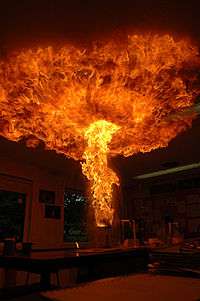
Cooking oil is flammable,[64] and fires may be caused by it igniting at too high a temperature.[65][66] Further, attempts to extinguish an oil fire with water cause an extremely dangerous condition, a boilover,[67] as they cause the water to flash into steam due to the high heat of the oil, in turn sending the burning oil in all directions and thus aggravating the fire. This is the leading cause of house fires in the United Kingdom. Instead, oil fires must be extinguished with a non-water fire extinguisher or by smothering. Other means of extinguishing an oil fire include application of dry powder (e.g., baking soda, salt)[68] or fire fighting foam. Most commercial deep fryers are equipped with automatic fire suppression systems using foam.
Spilled hot cooking oil can also cause severe third degree burns,[69][70] In the worst-case scenario, severe burns can be fatal. The higher temperatures[69] and tendency of oil to stick to the skin make spilled hot cooking oil far more dangerous than spilled hot water. Children can accidentally place their hands on top of the stove, playing with the materials while being cooked, or accidentally pull the pot down, which can cause significant injury.[71] The utmost care should be used when deep frying when children are present, to protect their safety at all times.[71][72]
Environmental
Deep frying produces large amounts of waste oil, which must be disposed of properly. Waste oil can contribute to the creation of fatbergs, overflow sewage systems, bind to the walls of sewage pipes, and interfere with sewage treatment.[73] Waste oil from deep frying is increasingly being recycled and refined into biodiesel.[74] Potatoes that are stored in artificially humidified warehouses contain more water, which makes the time required to deep fry them into chips longer. This increases the carbon dioxide footprint of commercially producing chips because more energy is required for frying over a longer time.[75] According to one source, an average home appliance deep fryer draws 2,000 watts.[76]
Health
The process of deep frying food is generally detrimental to its nutritional value. The oils that foods absorb in their batter typically contain large amounts of fats, especially saturated fats and trans fats. Consumption of large amounts of saturated and trans fats has been linked to a higher risk for some cancers including prostate cancer.[77] Eating deep-fried foods has also been linked to higher cholesterol levels, obesity, heart attacks, and diabetes.[78] Deep-fried foods cooked at certain temperatures can also contain acrylamide, a possible carcinogen.[79] Additionally, fat degradation processes (lipid peroxidation) during deep frying results in the loss of nutritional value in deep-fried foods.[80] Cooking oil that has been used for too long may in addition cause blood pressure elevation and vascular hypertrophy.[81]
Trans fats are used in shortenings for deep-frying in restaurants, as they can be used for longer than most conventional oils before becoming rancid. In the early 21st century, non-hydrogenated vegetable oils that have lifespans exceeding that of the frying shortenings became available.[82] As fast-food chains routinely use different fats in different locations, trans fat levels in fast food can have large variations.[83]
Some studies have found that deep frying in olive and sunflower oils has been found to be less of a detriment to health and in some cases have positive effects on insulin levels.[78] Oil can be reused a few times after original use after straining out solids.[18] However, excessive use of the same oil can cause it to break down and release compounds into the food that may be carcinogenic, affect liver health, or influence the body's ability to absorb vitamins. Some European countries have set public health standards for the safety of frying oil.[84]
See also
References
- Food Preparation and Cooking: Cookery units. Student guide. Catering and hospitality, NVQ/SVQ2. Stanley Thornes. 1996. p. 18. ISBN 978-0-7487-2566-3.
- America, Culinary Institute of (2007). Techniques of Healthy Cooking, Professional Edition. Wiley. p. 86. ISBN 978-0-470-05232-7.
- Sumnu, S.G.; Sahin, S. (2008). Advances in Deep-Fat Frying of Foods. Contemporary Food Engineering. CRC Press. pp. 6–7. ISBN 978-1-4200-5559-7.
- "deep-fried" (1916), "deep-frying" (1932), "to deep-fry" (1933) ""deep", adj". Oxford English Dictionary Online. Oxford University Press. Retrieved 24 May 2015. ""deep", v.". Oxford English Dictionary Online. Oxford University Press. Retrieved 24 May 2015.
- "Deep-Fried Foods". cooksinfo.com. Cooks Info. Retrieved 18 May 2015. "The ancient Greeks began frying foods in olive oil sometime around or after the 5th century BC. Frying foods in oil was common in Rome, certainly by the 1st century AD. Olive oil was mostly used, as it was plentiful. The Roman word was 'frigere.'"
- Lapetina, Adam. "The true origins of 11 of your favorite fried foods". thrillist.com. Trillist. Retrieved 18 May 2015.
- Wei, William (8 January 2013). The Definitive History of Deep-Fried Foods (Online video). New York City, United States of America: Business Insider.
- Antunes, Sonny. "Falafel, a dish the entire Middle East can agree on". finedininglovers.com. Fine Dining Lovers. Retrieved 18 May 2015.
- Guttman, Vered (24 April 2012). "No matter where it originated, falafel is still Israel's national food". Haaretz. Retrieved 18 May 2015.
- I. D., Morton. "Geography and history of the frying process". grasasyaceites.revistas.csic.es. Retrieved 18 May 2015.
- "Who invented french fries? France and Belgium battle over who invented fried, crispy potato perfection". Daily News. New York. AFP RELAXNEWS. 1 January 2013. Retrieved 18 May 2015.
- "The History of Fried Food". theex.com. Canadian National Exhibition. Retrieved 18 May 2015.
- "'Old Salt' Doughnut hole inventor tells just how discovery was made and stomachs of earth saved." Special to The Washington Post; The Washington Post (1877–1954), Washington, D.C; 26 March 1916; p. ES9
- "Onion Ring". ifood.tv. Retrieved 18 May 2015.
- Moss, Robert. "How Cajun deep fried turkey took over America". seriouseats.com. Serious Eats. Retrieved 18 May 2015.
- Neal, Rome (4 October 2002). "The science of corn dogs". CBS News. Retrieved 18 May 2015.
Corn dogs are a food that we know from fall festivals, carnivals and tailgating. It actually got its start when German immigrants moved into Texas. Some of these new German immigrants were sausage-makers by trade, but had a hard time selling their wares in Texas. So, as a ploy, they took sausages, rolled them in a cornbread batter and fried them. The sticks came later.
- Schreifer, K.; Sivell, J. (1997). 20 Questions-- Answered. 20 Questions-- Answered, Book One. Full Blast Productions. ISBN 978-1-895451-21-4.
- Bittman, Mark (21 October 2013). "Deep Fried and Good for You". The New York Times. Retrieved 22 May 2015.
- Joachim, David; Schloss, Andrew. "The Science of Frying". finecooking.com. Fine Cooking. Retrieved 31 July 2015.
- Cornelia Schinharl; Sebastian Dickhaut; Kelsey Lane (2003). Basic Asian: Everything You Need for Yin and Yang in the Kitchen. Silverback Books. p. 26. ISBN 978-1-930603-65-3.
- This, Hervé (2006). Molecular Gastronomy. Translated by Malcolm DeBevoise. New York: Columbia University Press. p. 63. ISBN 978-0-231-13312-8.
- Sweetser, W. (2004). The Ultimate Fryer Cookbook. Quintet Book. Running Press. p. 6. ISBN 978-0-7624-1963-0. Retrieved 18 May 2015.
- Pirie, G.; Clark, J.; Williams, C. (2006). Williams-Sonoma Bride & Groom Cookbook. Free Press. p. 229. ISBN 978-0-7432-7855-3. Retrieved 18 May 2015.
- "How To Clean A Deep Fryer – Deep Fat Fryer Cleaning". deepfryerreviewsdepot.com. Deep Fryer Reviews Depot. Archived from the original on 10 May 2015. Retrieved 20 May 2015.
- James Villas (2013). Southern Fried: More Than 150 Recipes for Crab Cakes, Fried Chicken, Hush Puppies, and More. Houghton Mifflin Harcourt. pp. 10–14. ISBN 978-1-118-13076-6.
- Dee Atkin. Delicious Deep Fried Recipes: Classic & Exotic Fried Chicken Recipes, Fried Rice Recipes, Fried Tofu Recipes, Fried Zucchini Recipes and More. p. 16. GGKEY:2LNT2E533SU.
- Tsuji, Shizuo (16 February 2007). Japanese Cooking: A Simple Art. Cookery, Food and Drink Series. Kodansha International Limited. pp. 103, 230. ISBN 978-4-7700-3049-8.
- Ashkenazi, M.; Jacob, J. (2013). The Essence of Japanese Cuisine: An Essay on Food and Culture. Taylor & Francis. p. 90. ISBN 978-1-136-81549-2.
- "Deep frying". Cookingonline.com. Retrieved on 18 May 2015.
- Taylor, J.M. (2013). Deep-Fried Goodness. Workman Publishing Company. ISBN 978-0-7611-7973-3.
- Catharina Y.W. Ang; Keshun Liu; Yao-Wen Huang (5 April 1999). Asian Foods: Science and Technology. CRC Press. p. 94. ISBN 978-1-56676-736-1.
- Fantozzi, Joanna (9 October 2014). "Eating Deep-Fried Maple Leaves Is Big in Japan". ABC News. Retrieved 24 May 2015.
- Smith, A.F. (2013). Food and Drink in American History: A "Full Course" Encyclopedia. ABC-CLIO. p. 351. ISBN 978-1-61069-233-5.
- Guides, R. (2012). Make the Most of Your Time in Britain. Rough Guides. p. 96. ISBN 978-1-4053-8861-0.
- Kaercher, D.; Stefko, B. (2006). Taste of the Midwest: 12 States, 101 Recipes, 150 Meals, 8,207 Miles and Millions of Memories. Best of the Midwest book series. Globe Pequot Press. p. 52. ISBN 978-0-7627-4072-7.
- "Photos: 75 deep fried foods". Chicago Tribune. 21 January 2015. Retrieved 22 May 2015.
- Booker, M. Keith (9 March 2012). Blue-Collar Pop Culture: From NASCAR to Jersey Shore (Volume 1 ed.). Praeger. p. 253. ISBN 978-0313391989. Retrieved 24 May 2015.
- Heine, P. (2004). Food Culture in the Near East, Middle East, and North Africa. Food culture around the world. Greenwood Press. p. 92. ISBN 978-0-313-32956-2.
- Murphy, A.; Armstrong, K.; Bainbridge, J.; Firestone, M.D. (2010). Lonely Planet Southern Africa. Country Regional Guides. Lonely Planet. p. 45. ISBN 978-1-74059-545-2.
- Albala, K. (2011). Food Cultures of the World Encyclopedia: [Four Volumes]. Food Cultures of the World Encyclopedia. ABC-CLIO. pp. 177–178. ISBN 978-0-313-37627-6.
- Solomon, C. (2006). The Complete Asian Cookbook. Tuttle Publishing. p. 464. ISBN 978-0-8048-3757-6.
- Newman, Judith. What is fried and has six legs? Welcome to Insect Cuisine. The New York Times. 20 May 1992. Retrieved 23 May 2015.
- Seubsman, Sam-ang; Kelly, Matthew; Pataraporn, Yuthapornpinit; Sleigh, Adrian (November 2009). "Cultural resistance to fast-food consumption? A study of youth in North Eastern Thailand". Int J Consum Stud. 33: 669–675. doi:10.1111/j.1470-6431.2009.00795.x. PMC 3086925. PMID 21547247.
- Nguyen, Andrea (1 June 2011). Into the Vietnamese Kitchen: Treasured Foodways, Modern Flavors. Potter/TenSpeed/Harmony. p. 513. ISBN 1607741415 – via Google Books.
- Ray, Nick; Bewer, Tim; Burke, Andrew; Huhti, Thomas; Seng, Siradeth. Vietnam, Cambodia, Laos & the Greater Mekong. p. 90 – via Google Books.
- Rossell, J.B. (2001). Frying: Improving Quality. Woodhead Publishing Series in Food Science, Technology and Nutrition. CRC Press. p. 31. ISBN 978-1-85573-556-9.
- "Deep-fried Mars bars: no link with sudden stroke – Health News". NHS Choices. 10 July 2014. Retrieved 24 May 2015.
- "Deep-fried Mars bars disowned by chocolate firm". BBC News. 5 September 2012. Retrieved 24 May 2015.
- Zaino, Caitlin (19 April 2013). "Chipping away at the history of fish and chips". BBC. Retrieved 24 May 2015.
- "8th International Symposium on Deep Frying Better understanding, better fried products 15–17 September 2015, Munich, Germany". eurofedlipid.org. Euro Fed Lipid. Archived from the original on 15 June 2015. Retrieved 12 June 2015.
- Smith, Kevin (4 June 2012). "What Happens When You Deep Fry An iPad?". Business Insider. Retrieved 20 May 2015.
- "Deep-Fried Gadgets: Artist Henry Hargreaves Deep-Fries (Fake) iPad, iPhone And More". The Huffington Post. 4 June 2012. Retrieved 24 May 2015.
- Gamble, Cole. "25 Deep-Fried Foods From the Texas State Fair". mentalfloss.com. Mental Floss. Retrieved 20 May 2015.
- "Come fry with me". The Economist. 8 October 2009. Retrieved 20 May 2015.
- "Deep Fried Masters". Discovery Networks. 12 July 2013. Archived from the original on 14 June 2015. Retrieved 23 May 2015.
- Lang, L.B. (2010). Australia. Eyewitness travel guides. Dorling Kindersley. p. 521. ISBN 978-0-7566-6082-6. Retrieved 23 May 2015.
- Krystina Castella (3 January 2012). A World of Cake: 150 Recipes for Sweet Traditions from Cultures Near and Far; Honey cakes to flat cakes, fritters to chiffons, tartes to tortes, meringues to mooncakes, fruit cakes to spice cakes. Storey Publishing, LLC. pp. 268–270. ISBN 978-1-60342-446-2.
- Mariod, Abdalbasit; Omer, Nuha; Al, El Mugdad; Mokhtar, Mohammed (9 September 2014). "Chemical Reactions Taken Place During deep-fat Frying and Their Products: A review". Sudan University of Science & Technology SUST Journal of Natural and Medical Sciences. Supplementary issue: 1–17.
- IARC Working Group on the Evaluation of Carcinogenic Risks to Humans (2010). Household use of solid fuels and high-temperature frying. Lyon, France ; Geneva: Lyon, France : International Agency for Research on Cancer ; Distributed by WHO Press, 2010.
- BBC (London) undated Which oils are best to cook with?
- Granda, C.; Moreira, R.G.; Tichy, S.E. (2004). "Reduction of Acrylamide Formation in Potato Chips by Low-temperature Vacuum Frying Journal of Food Science". 69 (8). Pages 405–411.
- Peng, S.K.; Morin, R.J. (1991). Biological Effects of Cholesterol Oxides. Taylor & Francis. p. 86. ISBN 978-0-8493-6776-2.
- "Chip pans". cambsfire.gov.uk. Cambridgeshire Fire and Rescue Service. Archived from the original on 20 May 2015. Retrieved 20 May 2015.
- Trudie du Toit, L.B. (2007). FCS Food Preparation L2. FET college series. Pearson Education South Africa. p. 95. ISBN 978-1-86891-824-9.
- Ferrier, S.; Shuttleworth, T. (1982). The KidsFood Cookbook. James Lorimer Limited, Publishers. p. 60. ISBN 978-0-88862-596-0.
- Trudie du Toit, Linda Botha (2007). FCS Food Preparation L2. Pearson South Africa. p. 96. ISBN 978-1-86891-824-9.
- Simpson, A. (2010). Food Porn Daily: The Cookbook. Sweetwater Press. p. 11. ISBN 978-1-59955-765-6.
- James Peterson (29 February 2012). Glorious French Food: A Fresh Approach to the Classics. Houghton Mifflin Harcourt. p. 550. ISBN 0-544-18655-9.
- Beasley, R.W. (2003). Beasley's Surgery of the Hand. Beasley's Surgery of the Hand. Thieme. p. 75. ISBN 978-1-58890-161-3.
- Anderson, L. V. "The Technique That Will Make You Want to Batter and Fry Everything". slate,com. Retrieved 31 July 2015.
- Chiarello, M.; Wisner, P.; Petzke, K. (2008). The Tra Vigne Cookbook: Seasons in the California Wine Country. Chronicle Books. p. 139. ISBN 978-0-8118-6379-7.
- Singh, P. (2012). The Everything Indian Slow Cooker Cookbook: Includes Pineapple Raita, Tandoori Chicken Wings, Mulligatawny Soup, Lamb Vindaloo, Five-Spice Strawberry Chutney...and Hundreds More!. Everything (Cooking). Adams Media. p. 13. ISBN 978-1-4405-4168-1.
- Carman, Tara (21 May 2015). "Grease, wet wipes clog Metro Vancouver's sewers". The Vancouver Sun. Retrieved 30 May 2015.
- Johanson, P. (2010). Biofuels: Sustainable Energy in the 21st Century. In the News. Rosen Pub. p. 18. ISBN 978-1-4358-3584-9.
- Murray, Sarah (14 December 2007). "The Deep-Fried Truth". The New York Times. Retrieved 22 May 2015.
- Jon Clift; Amanda Cuthbert (2007). Energy, Use Less—save More: 100 Energy-saving Tips for the Home. Chelsea Green Publishing Company. p. 13. ISBN 978-1-933392-72-1.
- "Study finds eating deep-fried food is associated with an increased risk of prostate cancer". fredhutch.org. Retrieved 19 May 2015.
- Davis, Robert. "Health Risks of Fried Foods May Be Overblown". Time. Retrieved 19 May 2015.
- Bruso, Jessica. "Are Deep-Fried Foods Harmful to the Health?". livestrong.com. The Livestrong Foundation. Retrieved 19 May 2015.
- Orozco-Solano, M. I.; Priego-Capote, F.; Luque de Castro, M. D. (10 May 2013). "Analysis of esterified and nonesterified fatty acids in serum from obese individuals after intake of breakfasts prepared with oils heated at frying temperature". Analytical and Bioanalytical Chemistry. Springer. 405 (18): 6117–6129. doi:10.1007/s00216-013-7004-0. ISSN 1618-2650. PMID 23657457.
- "Chun-Yi Ng, Yusof Kamisah, Othman Faizah , & Kamsiah Jaarin , 2013 Recycled Deep-frying Oil Causes Blood Pressure Elevation and Vascular Hypertrophy in Sprague-Dawley Rats 1(1) : 2-6". Archived from the original on 9 October 2016. Cite journal requires
|journal=(help) - NYC Board of Health. "Board of Health Approves Regulation to Phase Out Artificial Trans Fat: FAQ". Archived from the original on 6 October 2006. Retrieved 7 January 2007.
- "What's in that french fry? Fat varies by city". NBC News. 12 April 2006. Retrieved 7 January 2007. AP story concerning Stender, S; Dyerberg, J; Astrup, A (April 2006). "High levels of industrially produced trans fat in popular fast foods". N. Engl. J. Med. 354: 1650–2. doi:10.1056/NEJMc052959. PMID 16611965.
- Ogilvie, Megan (10 October 2014). "Deep fried food may be worse for you than you think". The Toronto Star. Retrieved 23 May 2015.
Further reading
- Erickson, M.D. (2007). Deep Frying: Chemistry, Nutrition, and Practical Applications. AOCS Press. ISBN 978-1-893997-92-9.CS1 maint: ref=harv (link) 447 pages.
- Kosa, Frank (16 October 2006). "Backstory: If you can think of it, he can deep fry it". The Christian Science Monitor. Retrieved 18 May 2015.CS1 maint: ref=harv (link)
External links
| Wikisource has original text related to this article: |


